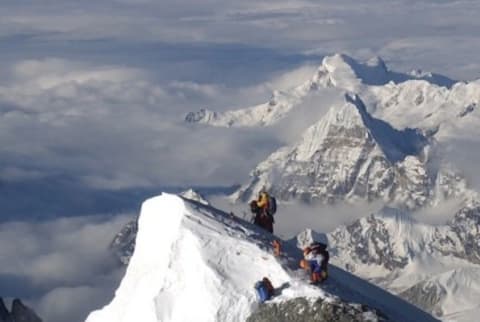Advertisement

Everyone has their mountains to climb. Most people’s are figurative, but mine are literal. I started climbing mountains in 1996 — about 18 months after my second heart surgery to correct a congenital heart defect called Wolff-Parkinson-White syndrome — and I haven’t stopped.
I have since served as the team captain of the first American Women’s Everest Expedition, climbed the highest peak on every continent (known as the “seven Summits’), and skied to both the North and South Poles, an accomplishment known as the Adventure Grand Slam.
In my book, On The Edge: The Art of High-Impact Leadership, I share advice about how to weather the storms without losing your way. Here are five things I learned from climbing that can be applied to any difficult situation:
1. Everything you need to survive can be carried on your back.
Once you come to realize that, it’s a pretty empowering feeling. Honestly, food, shelter clothing, that’s it — that’s all you need. Learn to live with just the basics, and then when you do have the “extras” it feels like you’re indulging, and you’ll appreciate the little things a lot more.
After spending a few weeks up high on the flanks of Mt. Everest, just taking a shower down at base camp with real soap and shampoo felt like a day at a luxury spa (even though I was standing underneath a plastic tarp on a bunch of jagged rocks, and the water that was coming out of the portable shower spout had been warmed up by a burning pile of yak dung just minutes before).
2. Surround yourself with people who will look out for you and help you muster up the courage to conquer things that intimidate you.
On Everest, one of the most frightening parts of the mountain is the Khumbu Icefall, two-thousand vertical feet of massive columns of glacial ice that can shift around at any moment and come tumbling down in a gigantic ice avalanche, crushing everything in their paths. The Icefall was the scene of a tragic accident this past spring that claimed sixteen lives. In total, I have climbed through that area about fourteen times, and it never gets “less scary.”
What gives me the courage to get through it time and time again? My team: the people climbing alongside me and encouraging me and cheering me on and waiting on the trail for me so that I don’t have to approach the terrifying parts alone.
3. Find the voice.
Everyone has it. Not everyone hears it. In 2002, my team turned back just a few hundred feet from the top of Mt. Everest during a storm. We were caught in a whiteout and were forced to abandon our summit attempt.
Fast forward to 2010. I’m back on Mt. Everest and am making another attempt to reach the top. And go figure, in comes a storm again. I thought, “There is no way I can continue climbing in this weather.” But then I thought, “Well … I can take one more step.” And I did. So then I thought, “OK, just one more.” And again, I did. And then I took one more after that … and another … and another … and eventually I found myself standing on the summit.
Once you’ve summoned that inner voice that tells you that you can take that next step, you know you can call it up again whenever you need it. This is the most powerful voice of all.
4. Progress does not always mean going forward.
When you’re climbing Mt. Everest, you don’t just climb in the upward direction to get to the top. You also spend a lot of time climbing downward, back toward base camp.
Why? Because you have to let your body get used to the altitude very slowly (a process called “acclimatization”), and that means coming back to a lower elevation several times throughout the expedition so that you can regain some strength since your body starts to deteriorate at elevations above 18,000 feet.
Coming back down to base camp each time before climbing to the next higher camp can be both physically and psychologically exhausting. But it’s part of the process, so don’t look at “going backward” as losing ground. Look at it as an opportunity to re-energize so that you’re a stronger climber when you head back up the mountain again. Backing up is not the same as backing down.
5. Grit is more important than speed.
Rarely (if ever) am I the strongest, fastest climber on an expedition. But I am determined. Pain is often part of the process when you’re pushing your limits. Junko Tabei reached the summit of Mt. Everest on May 16, 1975, and became the first woman to stand on top of the 29,035 foot peak. What makes this accomplishment even more impressive is that she and her teammates were struck by an avalanche at 20,600 feet and it took six Sherpas to dig them out.
Junko was in agonizing pain after the accident and could barely walk. Yet she powered on. When commenting on her historic climb she said, “Technique and ability alone do not get you to the top — it is the willpower that is the most important. This willpower you cannot buy with money or be given by others — it rises from your heart.”
You don’t have to be the best climber to get to the top of a mountain; you just have to be relentless about putting one foot in front of the other.
